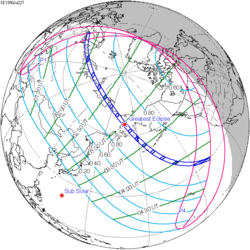| Annular eclipse | |
| Gamma | −0.9375 |
|---|---|
| Magnitude | 0.9957 |
| Maximum eclipse | |
| Duration | 22 s (0 min 22 s) |
| Coordinates | 51°18′S7°06′W / 51.3°S 7.1°W |
| Max. width of band | 44 km (27 mi) |
| Times (UTC) | |
| Greatest eclipse | 13:26:42 |
| References | |
| Saros | 148 (22 of 75) |
| Catalog # (SE5000) | 9579 |
An annular solar eclipse will occur at the Moon's descending node of orbit on Sunday, May 9, 2032, [1] with a magnitude of 0.9957. A solar eclipse occurs when the Moon passes between Earth and the Sun, thereby totally or partly obscuring the image of the Sun for a viewer on Earth. An annular solar eclipse occurs when the Moon's apparent diameter is smaller than the Sun's, blocking most of the Sun's light and causing the Sun to look like an annulus (ring). An annular eclipse appears as a partial eclipse over a region of the Earth thousands of kilometres wide. The Moon's apparent diameter will be near the average diameter because it will occur 5.7 days after perigee (on May 3, 2032, at 21:40 UTC) and 7.4 days before apogee (on May 16, 2032, at 23:20 UTC). [2]
Contents
- Images
- Eclipse timing
- Places experiencing partial eclipse
- Eclipse details
- Eclipse season
- Related eclipses
- Eclipses in 2032
- Metonic
- Tzolkinex
- Half-Saros
- Tritos
- Solar Saros 148
- Inex
- Triad
- Solar eclipses of 2029–2032
- Saros 148
- Metonic series
- Tritos series
- Inex series
- See also
- References
- External links
Since most of the path of this eclipse is narrow and passes over the South Atlantic Ocean, no land areas will witness annularity. However, a partial eclipse will be visible for parts of southern South America and Southern Africa.



































































































